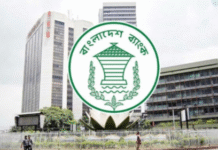Though the production cost of paddy has shot up by Tk 35 per maund between the last and the current Aman season, there has been no corresponding increase in its selling price.
The retail and wholesale prices of rice at district level has also increased by 20 and 30 percent respectively over the same period, indicating that it is the middleman who are making the quick buck, leaving the growers’ with a meager and unsatisfactory profit margin.
According to Department of Agriculture Extension (DAE), about 40 percent of the paddy harvest this Aman harvest has completed by now.
Talking to UNB, traders and millers at different districts said although their purchase price of per maund paddy was hovering over Tk 750-800 just two weeks back, the current prices is no more than Tk 730-750.
Raihanul Alam, a rice-miller in Panchgarh, said the current price of paddy at growers’ level is even lower compared to the price fixed for government procurement.
Food Planning and Monitoring Committee (FPMC) at the Food Ministry on November 27 made an announcement that government will procure two lakh metric tonnes of Aman rice at Tk 30 per kilogram.
The FPMC also claimed that farmers have to spend Tk 17.02 on producing per kg of paddy this year while the production cost of rice is Tk 25.42 per kg.
M Shahadat Hossain, a farmer from Durgapur village in Rangpur sadar upazila, said, “I sold out BINA-7 I planted as a bit early than the Aman season. I harvested it 20 days earlier and sold it at Tk 800 per maund.”
“The rest of the paddy in my fields is yet to be harvested. I planted Swarna in most of my lands, and some BRRI-11 and Kalijira that I will harvest in a few days. But the price is a bit dull right now — Tk 740 per maund,” he added.
Shahadat said the diesel price is higher than the price previous year and the daily labour cost during this harvesting season has also increased by Tk 100 per farm labourers. “The cost of growing paddy has increased, but the price has not increased accordingly,” he added.
Bangladesh Krishak Samity President Morshed Ali said, “We observe that the government’s procurement decision always comes at a time when the farmers sell out their harvests to traders at lower prices, incurring huge losses. So, it can be said the procurement drives by the government have been benefiting the traders instead of the farmers.”
Besides, the volume of government procurement is pretty small to have any impact on the market, he noted.
The DAE has already estimated that farmers have cultivated Aman in about 58 lakh hectares of land this fiscal, exceeding the government’s target by 2 lakh hectares beyond.
The DAE fixed the production target at 132.76 lakh tonnes in this Aman season. Last year, the country harvested 128.97 lakh tonnes of Aman rice from 56.1 lakh hectares of land.
Despite the stagnancy in the paddy prices at the growers’ level, the prices of the boiled and husked rice at the wholesale and the retail stages have marked a significant rise over the last 12 months.
According to the Department of Agricultural Marketing (DAM), rice price is ranging between Tk 34-37 (Sawrna variety in Rangpur-Dhaka) and Tk 46-52 (Miniket variety in Kushtia-Dhaka).
According to National Food Policy Capacity Strengthening Programme (NFPCSP), the retail and wholesale prices of coarse rice have marked a rise by 23.9 percent and 37.8 percent respectively in the city markets in the first half of November compared to the prices one year back.
The latest issue of the Fortnightly Foodgrain Outlook, a publication of the NFPCSP, said the retail and wholesale prices of one kilogram of coarse rice (Swarna) stood at Tk 35.50 and Tk 33.50 respectively in city markets in mid-November.
Source: UNBConnect










